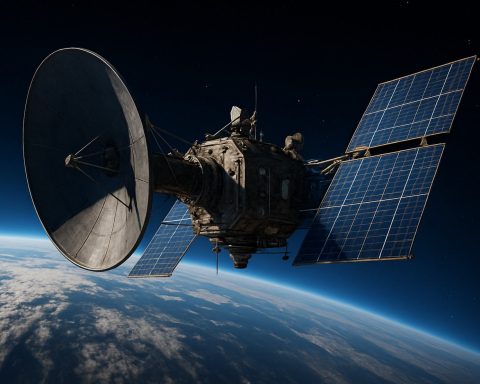Bandwidth Wars: Unraveling the Race for High-Throughput Satellite Supremacy
- Market Overview: Shaping the High-Throughput Satellite Ecosystem
- Technology Trends: Innovations Driving Satellite Capacity
- Competitive Landscape: Key Players and Strategic Moves
- Growth Forecasts: Projections and Market Trajectories
- Regional Analysis: Geographic Hotspots and Emerging Markets
- Future Outlook: Evolving Scenarios and Strategic Implications
- Challenges & Opportunities: Navigating Risks and Unlocking Potential
- Sources & References
“High-Throughput Satellites (HTS) are spaceborne relays designed to deliver dramatically higher data rates than traditional wide-beam satellites.” (source)
Market Overview: Shaping the High-Throughput Satellite Ecosystem
The high-throughput satellite (HTS) market is entering a transformative decade, marked by intensifying competition among satellite operators, technology providers, and new entrants. The so-called “bandwidth wars” are being driven by surging global demand for data, the proliferation of connected devices, and the expansion of broadband access to underserved regions. Between 2025 and 2035, the HTS ecosystem is expected to witness unprecedented growth, innovation, and consolidation as stakeholders vie for dominance.
According to NSR, global HTS capacity supply is projected to exceed 60 Tbps by 2030, up from just 3 Tbps in 2020. This surge is fueled by the deployment of new geostationary (GEO) and non-geostationary (NGSO) constellations, including mega-projects like SpaceX’s Starlink, OneWeb, and Amazon’s Project Kuiper. These constellations are reshaping the competitive landscape, challenging traditional GEO operators such as SES, Intelsat, and Eutelsat, who are responding with their own next-generation HTS platforms.
Pricing pressure is a defining feature of the bandwidth wars. The cost per megabit delivered via satellite has plummeted, with SpaceNews reporting a 60% drop in wholesale HTS capacity prices between 2017 and 2023. This trend is expected to continue as capacity floods the market, forcing operators to differentiate through service quality, coverage, and vertical integration.
Key battlegrounds include:
- Mobility Markets: Aviation, maritime, and land mobility are driving demand for seamless, high-capacity connectivity. Inmarsat, Viasat, and Panasonic Avionics are investing heavily in HTS to capture these segments.
- Emerging Markets: Africa, Latin America, and Southeast Asia represent significant growth opportunities as governments and enterprises seek to bridge the digital divide.
- Enterprise and Government: Secure, resilient, and high-throughput links are critical for defense, disaster response, and remote operations.
Looking ahead, the bandwidth wars will be shaped by advances in digital payloads, optical inter-satellite links, and ground segment virtualization. Strategic partnerships, mergers, and vertical integration will likely accelerate as players seek scale and differentiation. Ultimately, the winners will be those who can deliver affordable, reliable, and ubiquitous connectivity in an increasingly crowded orbital environment (Euroconsult).
Technology Trends: Innovations Driving Satellite Capacity
The satellite communications industry is entering a new era defined by the so-called “Bandwidth Wars,” as operators race to deliver unprecedented high-throughput satellite (HTS) capacity between 2025 and 2035. This competition is fueled by surging global demand for broadband connectivity, the proliferation of data-intensive applications, and the need to bridge the digital divide in underserved regions.
HTS technology leverages spot beam architectures, frequency reuse, and advanced modulation techniques to dramatically increase data throughput compared to traditional satellites. According to NSR, global HTS capacity supply is projected to exceed 100 Tbps by 2030, up from less than 10 Tbps in 2020, representing a tenfold increase in just a decade.
- LEO Mega-Constellations: Companies like SpaceX Starlink, OneWeb, and Amazon Kuiper are deploying thousands of low Earth orbit (LEO) satellites, promising low-latency, high-capacity global coverage. Starlink alone aims for over 40,000 satellites, targeting multi-terabit per second throughput by 2030.
- GEO and MEO Upgrades: Traditional geostationary (GEO) and medium Earth orbit (MEO) operators are not standing still. SES’s O3b mPOWER and Intelsat are launching next-generation HTS platforms, integrating digital payloads and flexible beamforming to compete with LEO offerings.
- Frequency Expansion: The adoption of higher frequency bands (Ka, Q/V, and even optical) is unlocking new spectrum and further boosting capacity. The ITU is actively coordinating global spectrum allocations to support this growth.
The stakes are high: the global satellite broadband market is forecast to reach $19.4 billion by 2030, with HTS capacity pricing expected to decline as competition intensifies. Operators are investing heavily in ground segment innovation, software-defined networking, and AI-driven resource management to maximize efficiency and differentiate their offerings.
Ultimately, the Bandwidth Wars will reshape the satellite industry landscape, determining which players dominate the next decade of global connectivity and digital transformation.
Competitive Landscape: Key Players and Strategic Moves
The global high-throughput satellite (HTS) market is entering a pivotal decade, with established aerospace giants and disruptive newcomers vying for dominance in what is often dubbed the “bandwidth wars.” As demand for broadband connectivity surges—driven by remote work, IoT expansion, and underserved regions—key players are investing heavily in next-generation satellite constellations and ground infrastructure to capture market share through 2035.
- SpaceX (Starlink): With over 5,000 satellites in orbit as of early 2024, Starlink leads the LEO (Low Earth Orbit) HTS segment, offering global broadband and targeting both consumer and enterprise markets. SpaceX’s aggressive launch cadence and vertically integrated supply chain have enabled rapid expansion, with plans to deploy up to 42,000 satellites (SpaceX Updates).
- OneWeb: Backed by the UK government and Bharti Global, OneWeb is building a 648-satellite LEO constellation, focusing on enterprise, government, and aviation connectivity. The company emerged from bankruptcy in 2020 and is now targeting global coverage by 2025 (OneWeb Media Center).
- Amazon (Project Kuiper): Amazon’s Project Kuiper aims to launch over 3,200 LEO satellites, with initial launches slated for 2024 and commercial service expected by 2026. Amazon’s cloud and logistics ecosystem could provide a competitive edge in service bundling and distribution (Amazon Project Kuiper).
- Viasat & Inmarsat: Following Viasat’s $7.3 billion acquisition of Inmarsat in 2023, the combined entity is leveraging GEO (Geostationary Earth Orbit) and LEO assets to offer hybrid HTS solutions, targeting aviation, maritime, and government sectors (Viasat-Inmarsat Press Release).
- Eutelsat & SES: European incumbents Eutelsat and SES are investing in next-gen GEO and MEO (Medium Earth Orbit) satellites, with Eutelsat’s merger with OneWeb creating a unique multi-orbit offering. SES’s O3b mPOWER constellation is set to deliver terabit-scale throughput for enterprise and government clients (SES O3b mPOWER).
Strategic moves include vertical integration, multi-orbit architectures, and partnerships with telecoms and cloud providers. The competitive landscape is expected to intensify as regulatory approvals, spectrum allocation, and cost-per-bit economics become decisive factors. By 2035, the HTS market could exceed $30 billion annually, with the winners defined by their ability to deliver reliable, affordable, and scalable bandwidth worldwide (NSR HTS Market Report).
Growth Forecasts: Projections and Market Trajectories
The global high-throughput satellite (HTS) market is entering a pivotal decade, with bandwidth demand surging across commercial, government, and consumer sectors. As the “bandwidth wars” intensify, industry leaders are investing heavily in next-generation satellite constellations, ground infrastructure, and spectrum rights to secure dominance through 2035.
According to MarketsandMarkets, the HTS market is projected to grow from $8.9 billion in 2023 to $22.7 billion by 2028, at a CAGR of 20.7%. This trajectory is expected to accelerate further as new players enter the fray and established operators expand their fleets. The proliferation of low Earth orbit (LEO) and medium Earth orbit (MEO) constellations—led by companies such as SpaceX (Starlink), OneWeb, and Amazon (Project Kuiper)—is set to dramatically increase global bandwidth capacity and coverage.
- Capacity Expansion: By 2030, global HTS capacity is forecast to exceed 50 Tbps, up from less than 10 Tbps in 2022 (NSR).
- Market Segmentation: The enterprise and mobility segments (including in-flight connectivity, maritime, and remote enterprise) are expected to account for over 60% of HTS revenue by 2030, driven by digital transformation and IoT adoption (Satellite Today).
- Regional Growth: Asia-Pacific and Africa are poised for the fastest growth, as governments and telecoms seek to bridge the digital divide and support 5G backhaul (GlobeNewswire).
Competition is also intensifying around spectrum allocation and regulatory frameworks. The International Telecommunication Union (ITU) and national regulators are under pressure to balance the needs of satellite operators with terrestrial 5G and other wireless services (ITU).
Looking ahead, the bandwidth wars will be shaped by technological innovation (such as software-defined payloads and optical inter-satellite links), vertical integration, and strategic partnerships. The winners will be those who can deliver reliable, affordable, and scalable connectivity to underserved markets, while navigating an increasingly complex regulatory and competitive landscape.
Regional Analysis: Geographic Hotspots and Emerging Markets
The global race for high-throughput satellite (HTS) dominance is intensifying, with regional dynamics shaping the competitive landscape from 2025 to 2035. As demand for broadband connectivity surges, especially in underserved and remote areas, satellite operators and technology providers are targeting geographic hotspots and emerging markets to secure market share and drive revenue growth.
- North America: The region remains a leader in HTS deployment, driven by established players such as SpaceX (Starlink), Amazon (Project Kuiper), and Viasat. The U.S. government’s push for rural broadband and the FCC’s Rural Digital Opportunity Fund are accelerating satellite internet adoption (FCC). By 2030, North America is projected to account for over 30% of global HTS capacity, with a focus on mobility, enterprise, and government applications (NSR).
- Asia-Pacific: Rapid urbanization and digital transformation are fueling HTS demand in Asia-Pacific, particularly in India, China, Indonesia, and the Philippines. The region is expected to witness the fastest growth, with a CAGR exceeding 15% through 2030 (GlobeNewswire). Local operators like China Satcom and ISRO, alongside global entrants, are investing in new constellations to bridge the digital divide.
- Europe: The European Union’s Secure Connectivity Initiative and projects like Eutelsat’s KONNECT are bolstering HTS infrastructure. Europe is focusing on sovereignty, security, and rural coverage, with the market expected to reach $6 billion by 2030 (Euroconsult).
- Latin America & Africa: These regions represent the largest untapped markets, with less than 40% internet penetration in many countries. Operators such as SES, Hughes, and regional startups are targeting these areas with affordable HTS solutions. By 2035, Latin America and Africa could collectively account for 20% of new HTS subscribers (Satellite Today).
In summary, the bandwidth wars are shifting toward emerging markets, where regulatory reforms, public-private partnerships, and innovative business models will determine the next decade’s HTS leaders. Regional strategies and local partnerships will be critical as operators vie for dominance in the high-stakes satellite connectivity arena.
Future Outlook: Evolving Scenarios and Strategic Implications
The next decade is poised to witness an intensification of the so-called “bandwidth wars” as satellite operators, technology giants, and emerging players vie for dominance in the high-throughput satellite (HTS) market. The global demand for data is projected to surge, driven by the proliferation of connected devices, the expansion of 5G/6G networks, and the digital transformation of industries such as aviation, maritime, and remote enterprise operations. According to NSR, global HTS capacity supply is expected to exceed 60 Tbps by 2030, up from less than 10 Tbps in 2022, with revenues surpassing $30 billion annually.
Key players such as SpaceX (Starlink), OneWeb, Amazon (Project Kuiper), and established GEO operators like SES and Viasat are investing heavily in next-generation constellations. These networks leverage advanced spot-beam technology, frequency reuse, and software-defined payloads to deliver unprecedented throughput and flexibility. The competitive landscape is further complicated by the entry of regional players in Asia, the Middle East, and Africa, who are targeting underserved markets with tailored solutions (Satellite Today).
- Technological Arms Race: The shift toward multi-orbit architectures (LEO, MEO, GEO) and the integration of optical inter-satellite links are expected to redefine network performance and latency benchmarks. Companies are racing to deploy software-defined satellites capable of dynamic resource allocation, enabling real-time adaptation to shifting demand patterns (Euroconsult).
- Regulatory and Spectrum Challenges: The scramble for spectrum rights and orbital slots is intensifying, with the ITU and national regulators under pressure to balance innovation with interference mitigation and equitable access (ITU).
- Strategic Implications: Operators must navigate a landscape marked by price compression, shifting value chains, and the need for vertical integration. Partnerships with telcos, cloud providers, and government agencies will be critical to unlocking new revenue streams and ensuring long-term viability.
Looking ahead to 2035, the bandwidth wars will likely yield a more consolidated market, with a handful of global and regional champions. The winners will be those who can combine technological innovation, agile business models, and strategic alliances to deliver affordable, high-quality connectivity at scale (McKinsey).
Challenges & Opportunities: Navigating Risks and Unlocking Potential
The global satellite communications industry is entering a transformative era, marked by the so-called “Bandwidth Wars”—a fierce competition among satellite operators to deliver unprecedented high-throughput connectivity. As we approach 2025 and look ahead to 2035, the race for high-throughput satellite (HTS) dominance is intensifying, driven by surging demand for broadband, the proliferation of connected devices, and the digitalization of remote regions.
- Escalating Capacity and Coverage Demands: The global satellite broadband market is projected to reach USD 19.4 billion by 2027, up from USD 10.5 billion in 2022, with HTS playing a pivotal role. Operators are racing to launch new constellations in geostationary (GEO), medium (MEO), and low Earth orbits (LEO) to meet the insatiable appetite for bandwidth, especially in underserved and rural areas.
- Technological Innovation and Spectrum Scarcity: The deployment of next-generation satellites—such as Viasat-3, SES O3b mPOWER, and SpaceX’s Starlink Gen2—promises terabit-level throughput. However, the finite nature of radio frequency spectrum and orbital slots is creating regulatory bottlenecks and intensifying competition for these critical resources (SpaceNews).
- Market Fragmentation and Price Pressures: The influx of new entrants and the expansion of mega-constellations are driving down bandwidth prices, challenging the profitability of legacy operators. This commoditization of capacity is forcing incumbents to innovate with value-added services and differentiated offerings (NSR).
- Opportunities in Emerging Markets and 5G Integration: The integration of HTS with terrestrial 5G networks presents a significant growth avenue, enabling seamless connectivity for IoT, mobility, and enterprise applications. Emerging markets in Africa, Asia, and Latin America are poised to benefit most, as satellite broadband bridges the digital divide (GSMA).
- Regulatory and Geopolitical Risks: National security concerns, export controls, and shifting regulatory frameworks could impede cross-border satellite operations and spectrum allocation, adding layers of complexity to the competitive landscape (ITU).
In summary, the Bandwidth Wars of 2025–2035 will be defined by rapid technological advances, aggressive market expansion, and complex regulatory dynamics. Operators that can navigate these risks and capitalize on emerging opportunities will shape the future of global connectivity.
Sources & References
- Bandwidth Wars: The High-Stakes Battle for High-Throughput Satellite Dominance (2025–2035)
- NSR
- SpaceNews
- Euroconsult
- SpaceX Starlink
- Amazon Kuiper
- SES O3b mPOWER
- Intelsat
- ITU
- USD 19.4 billion by 2027
- Amazon Project Kuiper
- Satellite Today
- GlobeNewswire
- Secure Connectivity Initiative
- McKinsey











